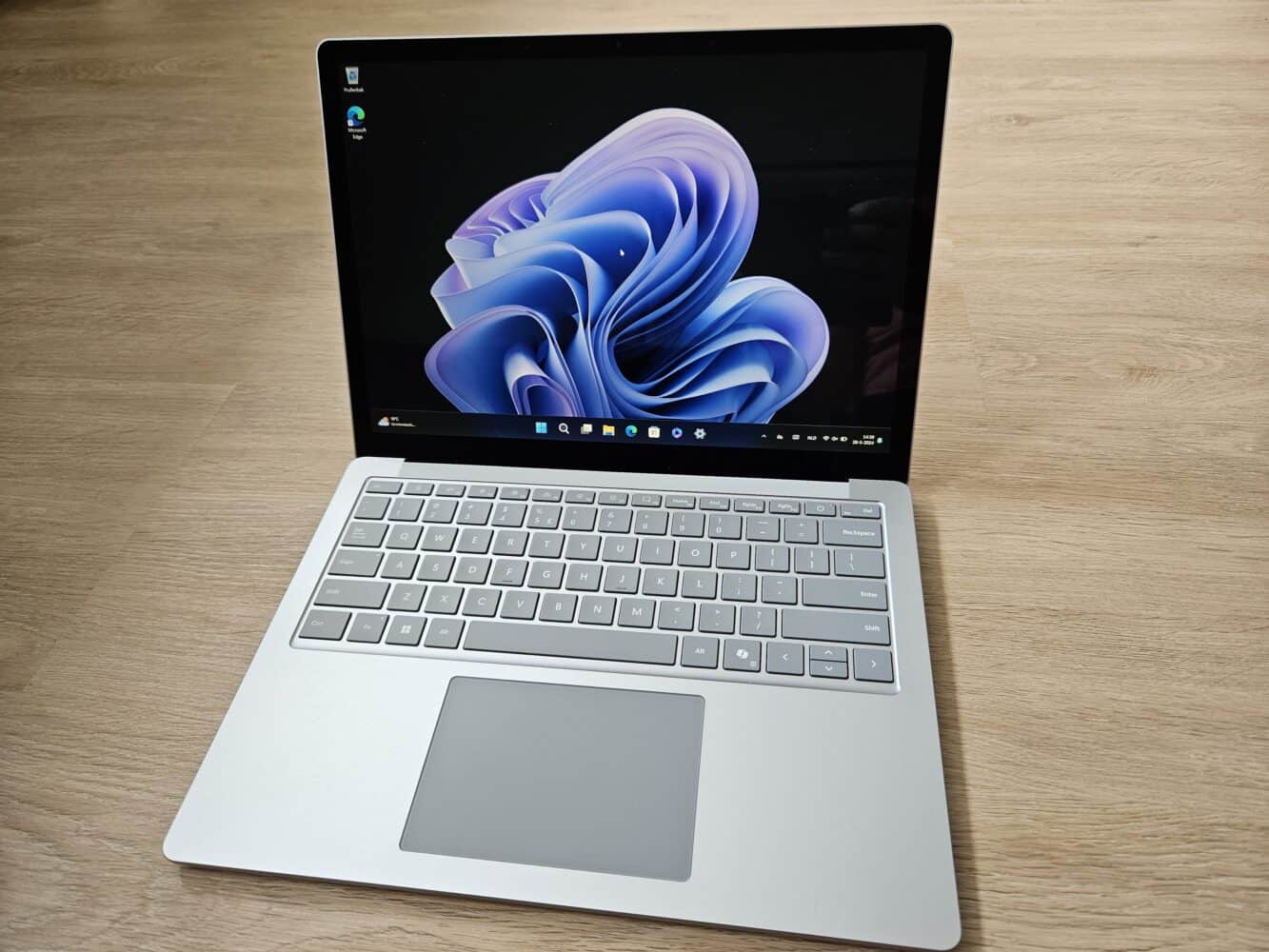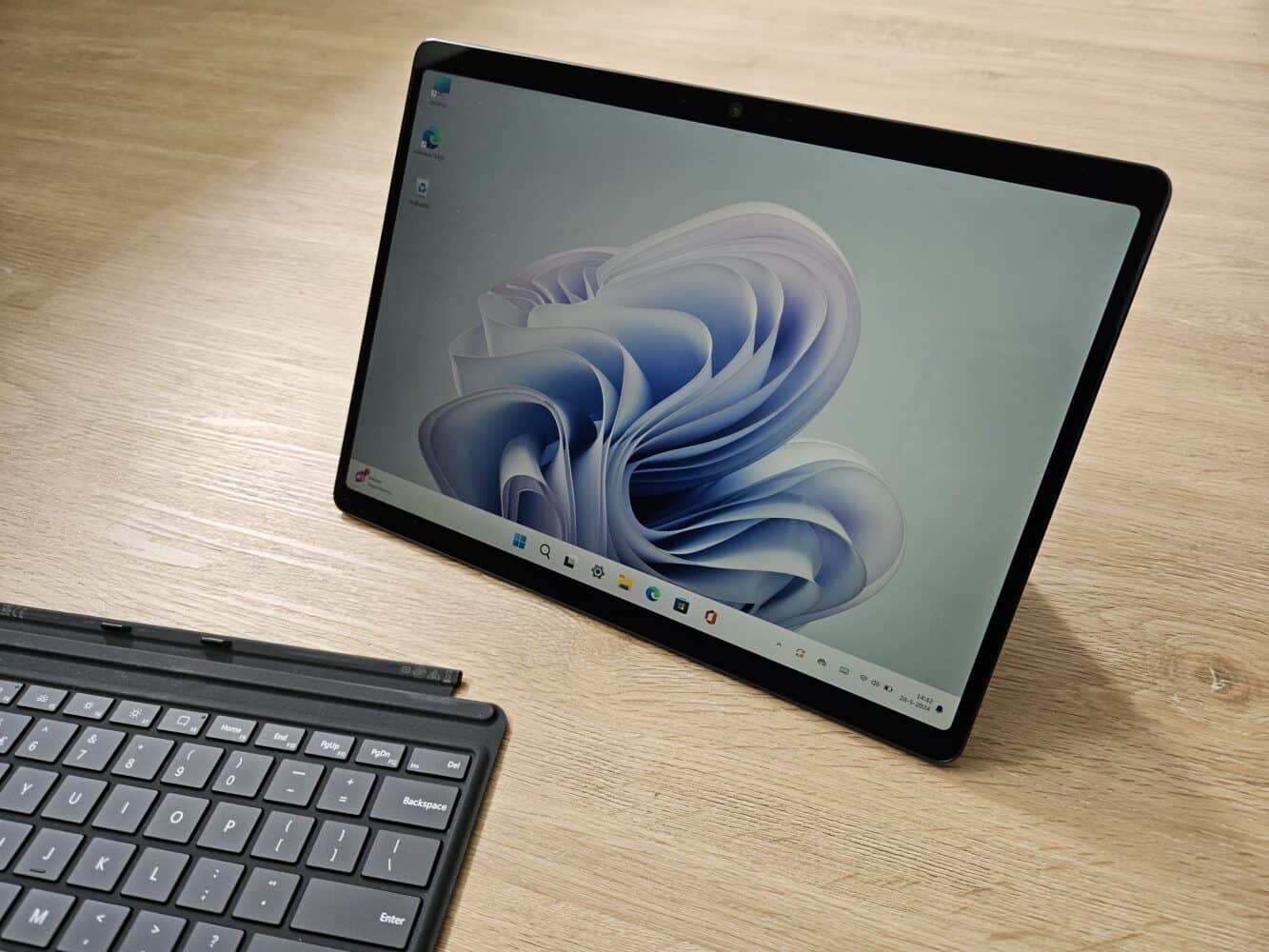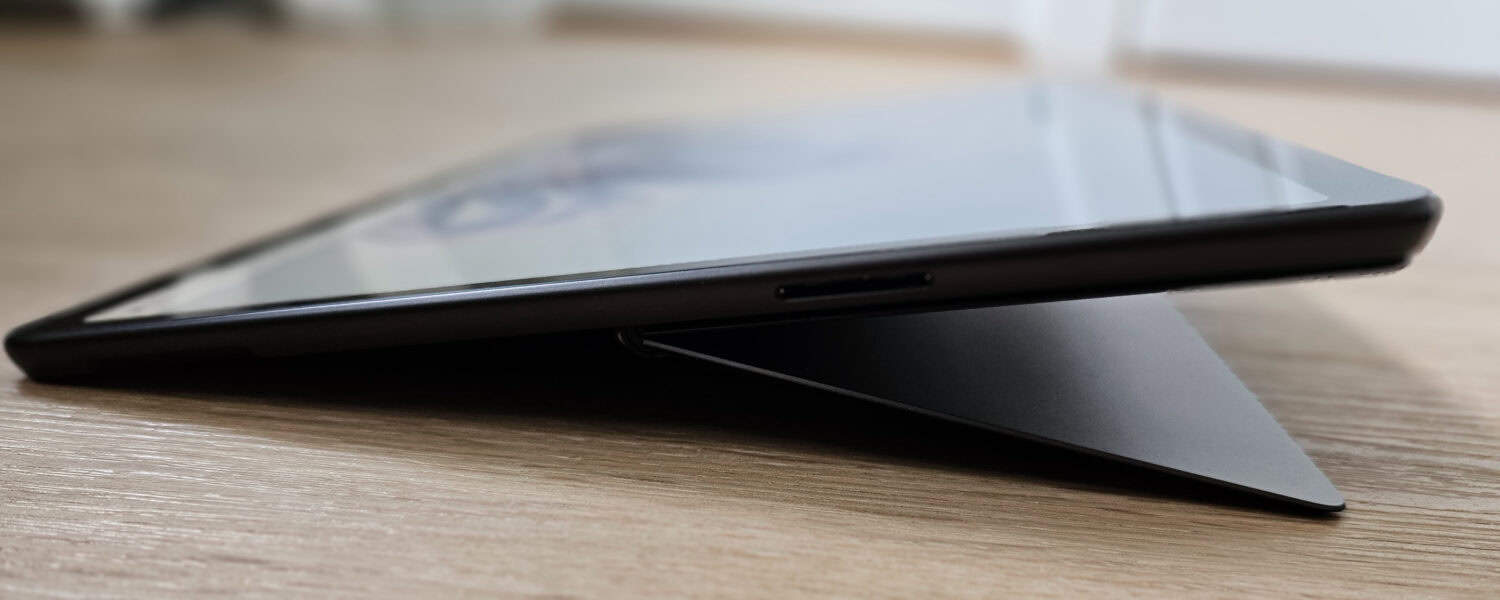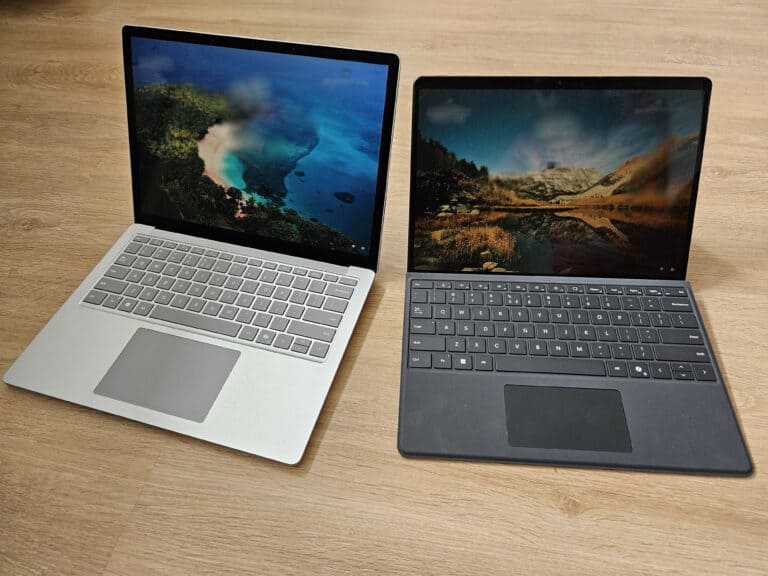The two latest additions to Microsoft’s Surface range are the Surface Pro 10 and the Surface Laptop 6. The former is a tablet PC with a detachable keyboard, while the latter is a ‘regular’ laptop. The two devices are often mentioned in the same breath, partly because their specs are similar. What they also have in common is that they are both stepchildren of the AI revolution, as their bona fide Copilot+ successors have already been announced and are even available for pre-ordering.
The devices seem all ready for the AI era, with a Copilot button included, but it seems these iterations in the super sleek Surface series with a price tag to match are just missing the boat called Copilot+. For one, they lack the minimum number of TOPS (trillion of operations per second) required by Microsoft’s guidelines to qualify for that label.
If you add up the number of TOPS the chipset can generate (11 for the integrated NPU, 18 for the GPU, and the 5 the CPU still manages to squeeze out), you arrive at 34 TOPS—too few for the 40 needed from the NPU alone for Copilot+ PC status.
Of course, that does not necessarily mean that these laptops would not be suitable for running local AI tasks. They have the required write space (256 GB minimum) and also the minimum required 16 GB of RAM, although there is even an 8 GB option. That’s nothing to write home about, but running AI workloads partially locally should at least be possible.
AI PCs delegate to the cloud what they cannot handle locally anyway. This is inevitable as Copilot is not just a chatbot but the glue that binds ever more Windows components together, both offline and online. Also, if even Chromebooks don’t need an NPU…
Confusing marketing message
Of note, these devices lack the recently announced Copilot+ functionality. The much-talked-about Recall feature isn’t available here either. The first PCs with these functionalities will not be available until June 18. Pressing the Copilot button on the tested devices simply sends you to copilot.microsoft.com.
It is downright confusing that while the Surface Laptop 6 and Pro 10 have only just landed and have been branded ‘AI PC’, Microsoft also recently announced their so-called Copilot+ PCs. In its initial announcement, the company did not clarify which devices from its catalogue were being referred to. However, it is now clear that genuine Copilot+ devices run on Arm architecture thanks to Qualcomm’s Snapdragon X Plus and Elite processors. The Surface Laptop 6 and Surface Pro 10 reviewed here contain Intel chips.
A closer look at Microsoft’s promotional channels reveals that the company’s first Copilot+ PCs of its own make will be the Surface Laptop 7 and the Surface Pro 11. There will also be Copilot+ devices from the likes of Asus, Lenovo, HP and Dell. These will all have Qualcomm chipsets.
So, to make it abundantly clear: the models in this review are their predecessors. Both test models run on Windows 11 Pro, version 23H2. There is no trace of any locally running AI. A local version of Copilot will only become available in the 24H2 version of Windows 11, in Europe as a separate downloadable app in the Microsoft Store. You’ll never see functionalities like Recall on these devices, as that will only be available on PCs that officially have the Copilot+ label. At least for now.
Tip: These major computer brands have already announced their own Copilot+ pc’s
Virtually identical chipsets
The Surface Pro 10 comes with an Intel Core Ultra Processor, the choice is between an Ultra 5 135U or an Ultra 7 165U. The chipset includes an Intel Arc Graphics GPU and an AI Boost NPU. In terms of storage capacity, there are 256GB, 512GB, or 1TB models to choose from. Additionally, the SSD is user-replaceable. The RAM memory comes in either 8, 16, 32, or 64GB LPDDR5x.
The Ultra 5 variant has a base clock speed of 1.6 GHz with an associated consumption of about 15 watts. That can be boosted to 4.4 GHz, where power consumption rises to about 57 watts. The Ultra 7 has a base clock speed of 1.7 GHz and a maximum turbo frequency of 4.9 GHz. Its consumption rate is almost the same as the Ultra 5 variant, at least according to Intel.
The Laptop 6 has the same chipset and comes in the same flavours in terms of storage capacity and RAM memory. For those who like to nitpick, the Surface Laptop with the lowest RAM memory (8 GB) is the only variant without the ‘x’ behind its LPDDR5 designation, which means a slightly lower performance. The 6.4 Gbps versus 8.5 Gbps speed difference will barely be detectable without benchmarking. The Laptop 6 comes in a 13.5-inch and a 15-inch version. We tested the 13.5-inch one.

These specs are not particularly impressive, as is always the case with Surface devices. Their unique selling point is not their raw power but sleek design, build quality, security options and suitability for business use cases. Both devices are quite thin: the Surface 6 is 16.7 millimetres at its thickest point when closed, and the screen is about 3.8 millimetres thick when opened, according to the calliper used. Without any add-ons, the Pro 10 is about 9 millimetres thick. With its kickstand and type cover included, this thickness grows to 14.2 millimetres. That makes it feel quite robust, if not to say, quite beefy.
Battery life
What is noticeable about the Pro 10 is that it can get hot pretty quickly when discharging the battery. It does not take much for the temperature to rise: keeping a few browser tabs open or playing a movie seems to be enough. Not so much that the device becomes too hot to hold, but it’s noticeable all the same. The speed of the Pro 10 did not seem to suffer because of this.
Battery life for both devices is fine. On paper, both the Pro 10 and the 15-inch variant of the Laptop 6 last 19 hours. The 13-inch version of the Laptop 6 should last 18.5 hours, for those who like to keep score. None of the devices tested required interim charging during the test period, though the Pro 10 was completely empty upon arrival. A few hours of charging proved enough to last the entire test period.
I/O connections
The Pro 10 has two USB-C connections with Thunderbolt 4. These are located side by side on the left side of the screen when the device is used as a laptop (which means on top in tablet mode). They allow for charging of the device, data transfer, or connecting to up to two external displays with a maximum resolution of 4K.
Other I/O is limited to a Surface Connect port for charging or connecting a Surface Dock. The power and volume buttons are at the top (in laptop mode). The Surface 6 laptop offers just one USB C port (Thunderbolt 4), one USB-A 3.1 port and the Surface Connect connector. What the Laptop 6 does have that the Pro 10 does not is an old-fashioned 3.5mm audio jack for wired headphones.
Security
The Surface Pro 10 offers NFC authentication for logging in without a password and facial recognition with Windows Hello. Security is a major selling point, given that both the Pro 10 and its bigger brother are marketed as business PCs. Both devices have Windows 11 secured core, a set of hardware and software solutions designed to improve security, including the TPM2.0 required for Windows 11 and support for BitLocker.
The Laptop 6 does not have an NFC reader, though it does have integrated smart card reader authentication. However, this is only on the 15-inch version and is only available in the US and Canada, so we don’t have much use for that here.
The USB-C connectors on both devices feature Dynamic USB-C Disablement, which allows the ports’ functionality to be set—particularly useful for limiting undesirable data transfers. IT administrators can also manage their organization’s fleet of devices and apps via Microsoft Intune.

Cameras and displays
The Pro 10 features a front-facing 1440p Quad HD Surface Studio camera with an ultra-wide field of view. Windows Studio Effects can be used to get more out of the camera in terms of AI enhancements. Think artificial eye contact, blurring backgrounds and automatic framing. The Pro 10 also has a 10,5 MP Ultra HD (i.e. 4K) rear-facing camera. The Laptop 6 has to make do with a 1080p full-HD camera, front-facing only.
The Pro 10’s screen is a 13-inch PixelSense touchscreen with up to 10 touch points at a time. The aspect ratio is 3:2, and the resolution is 2880 x 1920. The maximum refresh rate is 120 Hz, and the screen comes with an anti-reflective coating. All in all, it looks very nice.
Quite a large tablet
The Surface Pro 10’s screen size is the same as that of its predecessor, which makes it rather large for tablet use. Users without big hands are better off using two hands while in tablet mode. The tablet is a bit too heavy (about 879 grams) to hold with one hand for long periods of time anyway, mainly because of its size. Your wrist might get painful if you do.
It is questionable whether a device like this really lends itself to such iPad-like use. The user interface is not at all optimized for finger movements and a relaxed posture. This remains a shortcoming of Windows tablets: one always feels a mouse, touchpad, or even a stylus is necessary, but those who are in the market for a Windows tablet know what they can expect.
In many cases, the specs outlined above also apply to the Laptop 6. What differs is that this device comes in both 13-inch and 15-inch versions. The resolution of the former is 2256 x 1504, and that of the latter is 2496 x 1664. So, just a little less than the Pro 10.
Other than that, the specs are almost identical. The Laptop 6 has a slightly brighter screen, with a Standard Dynamic Range of 600 nits instead of 400 on the Pro 10. Viewed side by side, the Laptop 6’s screen seems to show slightly deeper colours. The chosen colour profile seems to have little effect on that.
King of kickstands
Like all tablet PCs in the Surface series, the Pro 10 has a particularly functional kickstand. It folds out almost all the way, about 165 degrees, but also works if you unfold it minimally, say 15 degrees. This means you can unfold the kickstand at its furthest and lay the tablet almost completely flat without the kickstand collapsing (let’s call this coffee table mode), as well as stand it almost completely upright (good for video conferencing!).
If you put the device vertically, an angle of at least 45 degrees for the kickstand is recommended. Most importantly, the kickstand remains firmly in place in all positions.

The design for both devices is extremely minimalist, as we’ve come to expect from Surface devices. The materials feel premium, especially on the Laptop 6. Keystrokes and clicks on the touchpad lead to satisfying click sounds—loud enough to provide proper tactile feedback to the user but subtle enough not to become annoying.
The included keyboard for the Pro 10 we tested is the current one, not the version announced along with the Copilot+ PCs that can be used while being disconnected from the screen. Also, the one we tested had no recess to hold the Surface Slim 2 pen, which leads us to believe it’s simply an older model. Otherwise, it is still a fine option, but last-gen all the same.
Are these PCs still worth buying?
That leaves the question: are these PCs worth buying? That probably depends on how susceptible you are to the Copilot+ hype. The already announced successors based on Arm architecture make us particularly curious, not only about the new generation of PCs but also about how AI will turn the future of computing on its head. That said, the products reviewed here do feel a bit like old news. This reviewer would rather have played around with Copilot+ PCs.
That new generation, which will become available later this year, promises a more energy-efficient device that runs longer on one battery charge and costs less, if one is to believe the marketing talk. Whether Microsoft and the other OEMs deliver on those promises is another matter. Still, it raises the question of whether business professionals in the market for a new laptop would not be better off waiting a while until these new devices are launched. Then they can at least make a meaningful comparison.
Also read: Review: Samsung Galaxy Book4 Ultra – high-quality laptop, high price
